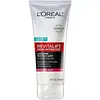What's inside
What's inside
 Key Ingredients
Key Ingredients

 Benefits
Benefits

 Concerns
Concerns

 Ingredients Side-by-side
Ingredients Side-by-side

Water
Skin ConditioningCoco-Betaine
CleansingPropylene Glycol
HumectantPEG-120 Methyl Glucose Dioleate
EmulsifyingSorbitol
HumectantGlycerin
HumectantGlycolic Acid
BufferingTriethanolamine
BufferingSodium Laureth Sulfate
CleansingSodium Chloride
MaskingDisteareth-100 Ipdi
Salicylic Acid
MaskingCapryloyl Salicylic Acid
ExfoliatingMenthol
MaskingAloe Barbadensis Leaf Juice
Skin ConditioningDisodium EDTA
Steareth-100
Gel FormingCitric Acid
BufferingPotassium Sorbate
PreservativeSodium Benzoate
MaskingWater, Coco-Betaine, Propylene Glycol, PEG-120 Methyl Glucose Dioleate, Sorbitol, Glycerin, Glycolic Acid, Triethanolamine, Sodium Laureth Sulfate, Sodium Chloride, Disteareth-100 Ipdi, Salicylic Acid, Capryloyl Salicylic Acid, Menthol, Aloe Barbadensis Leaf Juice, Disodium EDTA, Steareth-100, Citric Acid, Potassium Sorbate, Sodium Benzoate
Water
Skin ConditioningGlycolic Acid
BufferingAlumina
AbrasiveGlycerin
HumectantHydrogenated Polydecene
EmollientIsononyl Isononanoate
EmollientC12-15 Alkyl Benzoate
AntimicrobialGlyceryl Stearate
EmollientAmmonium Hydroxide
BufferingArginine
MaskingButylene Glycol
HumectantStearyl Alcohol
EmollientPolyacrylate-1 Crosspolymer
PEG-100 Stearate
Lactobionic Acid
BufferingPapain
Skin ConditioningCetyl Alcohol
EmollientHydroxypropyl Starch Phosphate
PEG-75 Stearate
Dehydroxanthan Gum
Emulsion StabilisingCeteth-20
CleansingSteareth-20
CleansingCarbomer
Emulsion StabilisingCaprylyl Glycol
EmollientAlgin
MaskingPhenoxyethanol
PreservativeChlorphenesin
AntimicrobialParfum
MaskingCI 19140
Cosmetic ColorantCI 14700
Cosmetic ColorantWater, Glycolic Acid, Alumina, Glycerin, Hydrogenated Polydecene, Isononyl Isononanoate, C12-15 Alkyl Benzoate, Glyceryl Stearate, Ammonium Hydroxide, Arginine, Butylene Glycol, Stearyl Alcohol, Polyacrylate-1 Crosspolymer, PEG-100 Stearate, Lactobionic Acid, Papain, Cetyl Alcohol, Hydroxypropyl Starch Phosphate, PEG-75 Stearate, Dehydroxanthan Gum, Ceteth-20, Steareth-20, Carbomer, Caprylyl Glycol, Algin, Phenoxyethanol, Chlorphenesin, Parfum, CI 19140, CI 14700
Ingredients Explained
These ingredients are found in both products.
Ingredients higher up in an ingredient list are typically present in a larger amount.
Glycerin is already naturally found in your skin. It helps moisturize and protect your skin.
A study from 2016 found glycerin to be more effective as a humectant than AHAs and hyaluronic acid.
As a humectant, it helps the skin stay hydrated by pulling moisture to your skin. The low molecular weight of glycerin allows it to pull moisture into the deeper layers of your skin.
Hydrated skin improves your skin barrier; Your skin barrier helps protect against irritants and bacteria.
Glycerin has also been found to have antimicrobial and antiviral properties. Due to these properties, glycerin is often used in wound and burn treatments.
In cosmetics, glycerin is usually derived from plants such as soybean or palm. However, it can also be sourced from animals, such as tallow or animal fat.
This ingredient is organic, colorless, odorless, and non-toxic.
Glycerin is the name for this ingredient in American English. British English uses Glycerol/Glycerine.
Learn more about GlycerinGlycolic Acid is arguably the most famous alpha hydroxy acid (AHA) with tons of research backing its benefits.
It is found naturally in sugar cane but the form used in skincare is usually synthetic for purity and stability.
Glycolic acid removes the top layer of dead skin cells to allow newer and fresher ones to emerge.
AHAs work by breaking down the structural “glue” that holds old skin cells in place. When that buildup is gone, your skin can renew itself more efficiently.
Research also shows glycolic acid stimulates collagen production, helping to firm and thicken the skin over time. This is one of its biggest advantages over other AHAs.
Overall, glycolic acid helps with:
Fun fact: Glycolic acid boosts skin hydration by helping it produce molecules that increase hyaluronic acid naturally.
To work best, glycolic acid products should have a pH between 3-4 (that’s where exfoliation is most effective but still gentle on skin).
The pH and concentration of a product are key to its effectiveness:
It is normal to feel a slight stinging sensation when using glycolic acid. This usually fades as your skin adjusts.
Because glycolic acid has the smallest molecular size in the AHA family, it can penetrate deeper, which enhances its effectiveness but also makes it more likely to irritate sensitive skin.
If your skin is very sensitive or prone to rosacea, glycolic acid may be too strong; in that case, try milder options like lactic acid or a PHA instead.
Recent studies suggest glycolic acid might even help protect against UV damage. But don’t skip sunscreen! Freshly exfoliated skin is more sensitive to the sun.
Glycolic acid is a skincare superstar. It smooths, brightens, hydrates, and firms the skin. Unless you’re highly sensitive, it’s well worth adding to your routine.
Read more about some other popular AHA's here:
Learn more about Glycolic AcidWater. It's the most common cosmetic ingredient of all. You'll usually see it at the top of ingredient lists, meaning that it makes up the largest part of the product.
So why is it so popular? Water most often acts as a solvent - this means that it helps dissolve other ingredients into the formulation.
You'll also recognize water as that liquid we all need to stay alive. If you see this, drink a glass of water. Stay hydrated!
Learn more about Water